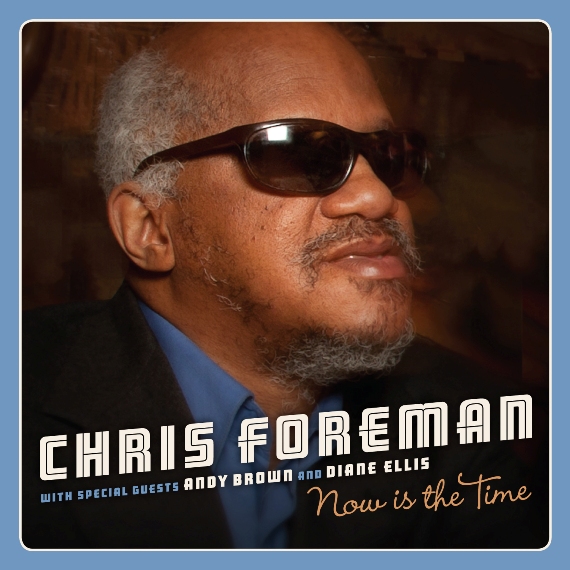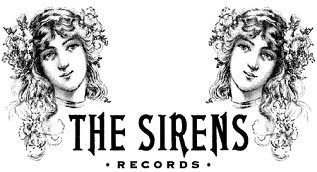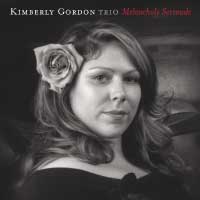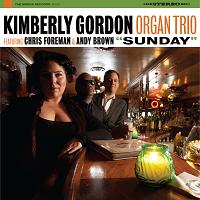Press / Music CD Reviews
Chicago's best jazz organist Chris Foreman Finally releases his debut album
It's hardly a secret that Chris Foreman has long been Chicago's best jazz organist. But the 57-year-old Hammond B3 master, blind since birth, has only now released his first recording under his own name. He's made a handful of killer records as a key member of the Deep Blue Organ Trio (with guitarist Bobby Broom and drummer Greg Rockingham); he's played behind singer, as well as Henry Johnson and Dave Specter; he's a fixture at the Green Mill, playing solo organ sets every Friday between 5 and 8 PM; he works in the Joel Paterson Trio each Sunday evening from 11 PM to 2 AM; and he still plays every Sunday at Saint James AME Church on 93rd Street, where he's been a member of the congregation for almost four decades.
Forman is not an experimenter. The music on the rousing Now is the Time (The Sirens) is deeply rooted in traditional sources—the blues and gospel—and each of the eight tunes are taken from a standard repertoire, whether it's the Charlie Parker title track or "Cotton Boy Blues," one of two tunes written by his biggest organ influence, Jimmy McGriff. On a few pieces Foreman borrows a tactic used by McGriff, swiveling between organ and an acoustic piano. He deploys that trick on a version of the Neil Hefti-penned "Lil' Darlin'"—a ballad made famous by Count Basie—one of four cuts featuring the guitar accompaniment of Andy Brown (alto saxophonist Diane Ellis plays on a version of Hank Crawford's "The Peeper," but otherwise Foreman plays solo), moving easily between churchy vibrato on organ and elegant lyricism on piano. The set is handily propelled by Foreman's deft use of the instrument's bass pedals, walking lines that push his gritty stabs and swells and elongated melodies toward body-swaying euphoria, and he's neither afraid to unleash the keyboard's fatback greasy side nor its sleek, glittery one.
Below you can hear his take on "Lonely Avenue," the Doc Pomus standard made famous by Ray Charles. There isn't an album release show on the books as of yet, but considering that Foreman performs in this format every Friday maybe it's time to drop in for one of those free weekend kickoff sets sooner than later.
Posted By Peter Margasak, Reader, Friday January 23, 2015 at 02.00 PM
Back To Top
Showing remarkable technique and copious amounts of spirit, Chris Foreman establishes himself as the rightful heir to Jimmy “King of the Blues Organists” McGriff on his first headliner album. He sweeps or staggers through tried-and-true jazz and r&b standards like a great, insurmountable force of nature. Broadening his keyboard concept, the Deep Blue Organ Trio charter member simultaneously plays B-3 and piano on Neil Hefti’s “Lil’ Darlin” and Hank Crawford’s “The Peeper.” Overdubbed piano adds to the quiet gospel sanctity of “Cotton Boy Blues,” a McGriff tune from the Groove Merchant 1970’s. Fellow Chicagoan Andy Brown on half of the tracks, shines more in self-communion with his guitar than he does complementing the organ, and alto saxophonist Diane Ellis guests on “The Peeper,” a stirring salute to McGriff and his close colleague Crawford.
 Soul time on the Hammond B3
Soul time on the Hammond B3
There are few musical sounds as deeply enveloping as the Hammond B3. Whether it’s murmuring warmly, rumbling at its bottom end or stabbing percussively with notes that sound like raw alternating current, the B3 is unmistakable. The Hammond’s variable tones contrast with the imitative voices of other organs, and require both a player’s technique and an artist’s imagination to shape sounds beyond well-defined stops. Moving from piano to organ is a leap, but moving from a standard organ to a B3 requires the player to develop a personal relationship with the instrument.
Chris Foreman is a Chicago-based organist whose style descends (as do most B3 players) from the epochal Jimmy Smith, along with Jimmy McGriff, “Brother” Jack McDuff, Shirley Scott, Richard “Groove” Holmes and others. He’s most regularly heard at his weekly gigs at the Southside’s Green Mill and St. James African Methodist Episcopal church, and on record with the Deep Blue Organ Trio. The trio’s renown expanded beyond the Windy City a few years ago with an opening slot on Steely Dan’s 2013 U.S. tour, and Foreman ventures forward now with this new album of duets.
The organ is able to stand on its own, provide the centerpoint of trios, or add muscle to larger groups. In duet settings it needs to converse, to ensure that it doesn’t overwhelm its partner. Foreman is skilled at playing both lead and accompaniment, stepping into the initial spotlight with fleet fingers and bold chords for the opening take on Charlie Parker’s “Now is the Time.” He edges slowly into “Shake a Hand,” with a late-night groove that favors Freddy Scott over Little Richard, underlining the piano with his organ and decorating the organ with the piano’s flourishes. You can catch occasional touches of Foreman’s classical training in his fingerings, but he’s never mannered; everything he plays truly swings.
Guitarist Andy Brown and saxophonist Diane Ellis guest on several tracks, providing worthy foils for Foreman’s B3. Brown kicks off a sprightly version of Doc Pomus’ “Lonely Avenue” before giving way to Foreman’s blue chords. Forman returns the favor as he vamps sympathetically behind Brown’s solo, and the two join together for a bridge that leads to Forman’s second variation on the song’s main theme. As someone who plays a weekly club gig, Foreman’s developed a wide-ranging repertoire, drawing upon tunes from Neal Hefti (the atmospheric “Li’L Darlin’”), saxophonist Hank Crawford (“The Peeper,” with Ellis as soloist) and Jimmy McGriff (“Doggone” and “Cotton Boy Blues”).
The organ can evoke memories of churches, movie theaters, county fairs, baseball parks, old-timey pizza restaurants, skating rinks, mall stores, or, perhaps most damning, you father’s den. But it can also evoke the soul of the blues like no other instrument, and in the hands of a master like Chris Foreman, the B3’s notes, chords, drones, bass and volume pedals provide otherworldly transportation to a smoky late-night club. Producers Steven Dolins and Jim Dejong, and engineer Steve Yates have done a superb job of capturing the B3’s wide range of volume and timbre, and have nicely balanced the guitar, saxophone and piano in the duets. Anyone who loves the B3 should check this out! [©2015 Hyperbolium]
As one of the house organists at the legendary The Green Mill, and member of various ensembles, Chris Foreman is one of Chicago’s unsung jazz heroes. As a sideman, Foreman has marked several recordings with his soulful, earthy grooves, and finally he has released an album under his own name. On his much-anticipated debut, Now is the Time, Foreman interprets – unaccompanied or in duets – several covers with his unique laid-back charm and organic style.
The title track for instance creates a stirring ambience with deep, funky bass lines and slow simmering chords. Foreman’s delightfully complex improvisation displays thrillingly boppish virtuosity as well as a deep sense of the blues.
Much like his greatest influence, Jimmy McGriff, Foreman often alternates masterfully between the Hammond B3 and acoustic piano. Foreman opens the former’s “Cotton Boy Blues” with overlapping gospel-ish organ and contemplative, angular piano phrases. The piano’s brief, percussive cascades echo the gritty organ’s swelling sonic waves creating a haunting, intricately woven piece both simultaneously evocative and ardent.
On half of the record, versatile guitarist Andy Brown joins Foreman for intriguing and intelligent dialogues. On the standard “I Cover the Waterfront,” Foreman’s sharp, crisp, yet thick tones build a buoyant spontaneous melody. Brown answers with resonant rhythmical strums. A quieter melancholic mood prevails on the second half with Brown’s reverberating strings flowing from Foreman’s wistful expectant refrains.
The disc closer, “The Peeper,” features alto saxophonist Diane Ellis, whose serpentine, agile silvery threads wind around Foreman’s hefty indigo-hued bars. The tune is the perfect pairing of Foreman and Ellis as saxophonist Hank Crawford – one of McGriff’s frequent collaborators – composed it. Ellis wails with warmth and passion over Foreman’s greasy, red-hot keys. A clear, acerbic tone marks her short yet emotive and lithe extemporization.
With this emerging, elegant and enjoyable work, Foreman demonstrates that he is a consummate musician and skillful performer who has forged a singular sound that is forward looking yet remains steeped in tradition. Of course, his audience have always known this, but now so will music lovers everywhere.
Hrayr Attarian, Chicago Jazz Magazine, September-October 2015
Back To Top
After three compact discs and a DVD with his trio-mates Bobby Broom and Greg Rockingham and a pair of sideman appearances with vocalist Kimberly Gordon, sightless Chicago organ master Chris Foreman has finally recorded his debut disc for The Sirens label.
For all intents and purposes it is a solo recital with the leader performing on organ plus piano added on four titles. He’s joined on the Ray Charles anthem, the Basie classic and the following two numbers by guitarist Andy Brown whose smooth lines lack the bluesy bite of such organ-associated string stalwarts as Jimmy Ponder or Melvin Sparks. The final track finds Foreman in the company of altoist Diane Ellis rendering her best Hank Crawford impersonation on the composer’s “The Peeper.”
Elsewhere, there are covers of the Bird title tune and a pair of scripts from the keyboardist’s admitted main influence, Jimmy McGriff, which lend themselves well to his Black gospel/blues-infused stylings. It is apparent that his long-running, solo one-night-a-week gig at the Windy Cities Green Mill has paid off big time.
Larry Hollis, Cadence Magazine, Volume 41, Number 3, 2015
Back To Top
Native Chicagoan Chris Foreman has become a fixture at the legendary Green Mill on the city’s North Side through his long-running gig at the center of the Deep Blue Organ Trio and backing vocalist Kimberly Gordon. Though he has made recordings both, this disc is his first under his own name.
The eight-track set roars out of the gate with an unaccompanied Foreman running through much of the organ’s tonal palette on the Charlie Parker title track. He adds his own piano to the churchy rendition of Faye Adam’s Shake a Hand that follows before guitarist Andy Brown adds his crisp lines to an unusual uptempo take on Ray Charles’ Lonely Avenue, the Neal Hefti-Count Basie, big-band classis Lil’ Darlin and an I Cover the Waterfront that recalls early Jimmy Smith. Brown is also heard on the first two cuts from Foreman’s mentor Jimmy McGriff, and the set concludes with Hank Crawford’s The Peeper, featuring a searing alto solo from Diane “Lil’ Sax” Ellis.
While not strictly a “blues album”, this is most definitely a bluesy one and – like most organ jazz – should appeal to LB readers.
Most Chicago jazz fans know exactly who Chris Foreman is…an outstanding organ player who is genuinely one of the greats playing the instrument these days. His playing with the Deep Blue Organ Trio, Kimberly Gordon and others is always top notch, and to tell the truth, it hadn’t dawned on me that he hadn’t released an album under his own name. Well, that’s been resolved with his debut album, Now Is the Time. What’s really interesting is the fact that large swaths of this disc is solo organ. Which admittedly doesn’t sound too enticing on paper. However, Foreman really shows off just how infectious of a player he is by making a disc like this. He swings mightily on Charlie Parker’s "Now’s the Time." Add in Andy Brown on guitar on a few cuts, or Diane Ellis on “The Peeper,” and you’ve got an embarrassment of riches. Hopefully, you’ll be hearing this one a lot!
Anyone with some basic interest in Chicago jazz has undoubtedly heard of Chris Foreman. Along with guitarist Bobby Broom and drummer Greg Rockingham, Foreman was a member of the Deep Blue Organ Trio, a group that played a big role in revitalizing the organ tradition in Chicago. He has also recorded two projects on the Sirens label backing singer Kimberly Gordon. And most Sunday evenings you can hear the organist along with the guitar wizard Joel Paterson at the Green Mill until the wee hours of the morning.
There are organists like Joey DeFrancesco and Tony Monaco, players with prodigious technical skill and the ability to improvise at all tempos, especially at a lightning-quick pace. Jimmy Smith is a legendary figure who had the technique but was also a master at creating a groove. Then there are organists who are all about the groove – Jimmy McGriff, Charles Earland, Dr. Lonnie Smith, Richard “Groove” Holmes and Brother Jack McDuff. You can add Chris Foreman to that storied roster.
In Foreman’s world, it is all about the feeling, the mood that he so successfully creates on each of the eight standards (all instrumentals) he selected for this project. You get that right from the start with a joyful rendition of the title track, written by Charlie Parker. It is just Foreman at the helm of the organ, his left hand walking the bass line while his right hand spins out an engrossing mixture of chords and single note runs. The combined effect will quickly have your body moving to the irresistible pull of the music he creates.
Four other tracks feature guitarist Andy Brown, a combination that allows both musicians to alternate between solos and maintaining the rhythm. Brown’s fluid, blues-based lead on “Lonely Avenue” sparks a mesmerizing solo excursion from Foreman. “I Cover The Waterfront” gets a playful treatment with Brown comping chords while the organist creates a series of witty twists on the melody. McGriff’s tune, “Doggone,” provides the framework for a tantalizingly swinging rhythm with Brown impressing over two segments of beautifully crafted single note picking.
The guitarist takes a sublime turn on the Neal Hefti classic, ”Lil’ Darlin’,” while Foreman impresses as he switches between organ and piano without missing a step. “The Peeper” pairs the organist with a long-time friend, Diane “Lil’ Sax” Ellis on alto sax, for a hearty romp that celebrates the beloved organ combo groove.
Through the use of overdubs, Foreman plays piano and organ on two tracks. He uses the organ to lay down a stately treatment of the melody to “Shake A Hand” while his fingers dart across the piano keyboard, generating soulful fills over the lush organ chords straight out of the church. Even better is the call-and-response between the instruments on “Cotton Boy Blues”. The full-bodied, rich organ tones set up the seductive slow blues. Foreman plays introspective interludes on the piano that create enthralling tonalities in conjunction with the organ. Towards the end of the disc’s longest track, Foreman takes a brief, killer break on the organ that adds a sense of drama to the finish.
Not much more needs to be said about this one. The “less is more” approach certainly for works Mr. Foreman, who delivers a command performance full of subtle musicality and inventive playing. This one will unquestionably be on my “Best of the Year” list. Highly recommended!



 2. Shake a Hand
2. Shake a Hand

